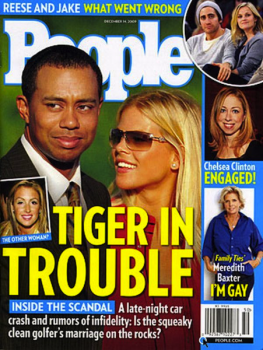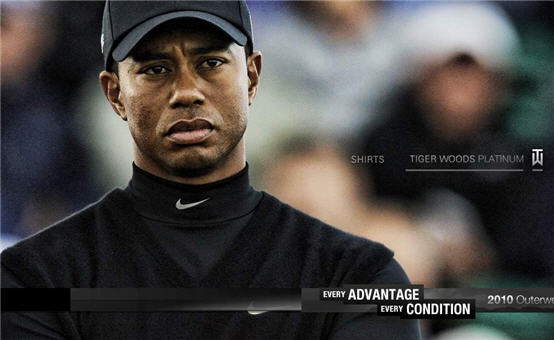Tiger! Tiger! Burning Bright
David L. Andrews / University of Maryland
Tiger: Sweaty Celebrity Pawn
In the end, it proved impossible to ignore. I had hoped to write my final Flow contribution focusing on the media-hype surrounding John Terry’s national team disrupting assignations, or even Tim Tebow’s representation as the poster child of the new Christian right. However, the half-life of each of these hot topics proved short, as they soon became submerged within the perpetual clutter of the sport media landscape. Of course, one sensationalist scandal has remained atop the pile of sport media detritus. Try as I might to avoid it, I kept being pulled back to the mass media’s response to Tiger Woods’ epiphanic automobile accident, and attendant facial lacerations, which ultimately lifted the lid on his “double life”.1
Understandably, the media chatter came to a crescendo during what were Woods’ first steps in what is likely to be an interminable, never-ending road to redemption: his return to the PGA golf circuit with his recent appearance at the 2010 Master’s Tournament at Augusta, GA.
One can only imagine the glee felt by CBS television executives at Wood’s decision to choose the 2010 Masters’ as the occasion and venue for his deliverance from the sexual addiction wilderness. In more routine circumstances, Wood’s presence in a tournament guarantees elevated television audience ratings as compared to the sans Woods condition. Thereby, in such times of tabloidic hyperscrutiny, one could have anticipated the mass media-cultivated and salacious inquisitiveness of the global viewing public to draw them in record numbers to this most pornographic of sporting moments. Such expectations were confirmed by television ratings up 43% on the opening day of coverage on ESPN, culminating in a 36% rise in CBS’ final day broadcast.2 There are, of course, numerous issues of interest and relevance which arise from the whole Woods’ scenario, however, I have chosen to focus on one; something about the workings of the promotional media complex that is at best naive, and at worst wholly disingenuous.3
People Magazine cover, December 14, 2009
Much of the post-revelation Woods’ circus would seem to have been fuelled by a media disgruntlement (which rapidly transformed into avaricious glee) that this most iconic of American, and indeed global, sporting figures had failed to live up to the public Tiger persona carefully constructed by his image management team over the preceding fourteen years or so. He was living this “double life” which pitted inauthentic “good Tiger” against what was subsequently revealed to be the authentic “bad Tiger.” Of course, the logic of such responses are rooted in the hack journalistic practice of looking to craft a story through the mobilization of simplistic binaries. Furthermore, it reveals a willing and strategic deceit regarding the workings of the contemporary celebrity media complex, of which journalists are such an integral part. As Whannel insightfully noted, “The comparison of image and reality, of represented star and real person becomes problematic when all we are dealing with is layer upon layer of mediation…Meanings emerge precisely from the representational practices of the media, and not simply from the inherent characteristics of the star represented”.4 With far too few exceptions, those writing within the various platforms (television, newspaper, magazine, web) of the sport media are little more than ancillary purveyors, and de facto authenticators, of commercially conceived imaged identities.
With the case of Woods, he was presented, and represented, to the global media audience via a series of television advertisements (for Nike, American Express, Gillette etc.) which nurtured a seemingly engaging–initially progressive yet increasingly banal–public persona through which Woods was able to safeguard his own identity (whatever that may have been).
Tiger as Inscrutable Nike shill
As John Feinstein noted, he became “The Invisible Man” who hid behind the “non-stop image crafting being done by Tiger and his managers at IMG”.5 Or, in Bissinger’s terms:
In an age of constant gotcha and exposure, he had always been the bionic man in
terms of personality, controlling to a fault and controlled to a fault, smiling with
humility and showing those pearly white teeth in victory or defeat, sui generis in the world of pro golf, where even fellow pros and other insiders didn’t really know him, because he didn’t want anybody to know him. With Woods, everything was crafted to produce a man of nothing, with no interior—non-threatening and non-controversial.6
While his star was in the ascendancy, it suited the other domains of the commercial media to enthusiastically corroborate this heavily sanitized imaged orthodoxy. Counter narratives may have periodically arisen, but they were routinely dismissed and/or ignored under the welter of the established Woods logic. Thus, uncritical Tiger fetishizations abounded within the commercial media until, of course, the established script was so rudely interrupted. Only at this point was the contrivance and insincerity of Woods’ imaged identity revealed. Subsequently (and perversely given the recent dissection of celebrity manufacture), we have witnessed an attempt to establish either the new authentic and sincere Tiger through restricted and highly orchestrated media performances (one of which is surely to be an appearance in the last throes of The Oprah Winfrey Show; that most visible of celebrity confessionals?), or the depths of sexual depravity of the real Tiger (as revealed by the in-depth investigations of the salacious and parasitic tabloid media).
Perhaps the strangest example of Woods’ representational strategies has been a recent Nike ad featuring a monochrome image of a suitably somber-looking Tiger Woods, whose late father, Earl, voices a pathway to redemption through self-examination. Whether successful or not, through such initiatives, the commercial media looks to encourage a willing suspension of disbelief in celebrity artifice, as the mechanism for engaging and seducing the consuming populace.
Tiger Woods Nike Ad, “Did You Learn Anything?”, April 2010
However, as if the workings of the celebrity-obsessed sport media complex were not sufficiently transparent, one only has to look to the end of 2010 Masters tournament. Framing the visually obtrusive yet compelling intimacy of winner Phil Mickelson’s tearful embrace of his wife, Amy–herself in the midst of a much publicised struggle against breast cancer–CBS commentator Jim Nantz opined, “That’s a win for the family”. This proved a catalyzing moment in the doubtless much anticipated and rehearsed anointing of Mickelson as the socially and morally upright anti-Tiger, and seeming embodiment of middle America’s affective and ideological sensibilities.7 Of course, it matters little if Mickelson is indeed a suitable candidate for such populist adulation, lest we forget that sport celebrities are “spectacular representations of living human beings”.8 They are no more nor less than (sometimes) compelling fictive illusions.
Phil Mickelson embracing his wife, Amy. April 11, 2010
Image Credits:
1. Tiger: Sweaty Celebrity Pawn
2. People Magazine cover, December 14, 2009
3. Tiger as Inscrutable Nike shill
4. Tiger Woods Nike Ad, “Did You Learn Anything?”, April 2010
5. Phil Mickelson embracing his wife, Amy. April 11, 2010
Please feel free to comment.
- Associated Press (2010, April 2). “Woods lookalikes are hoping for a comeback, too.” http://www.nytimes.com/2010/04/04/sports/golf/04doubles.html [↩]
- Associated Press (2010, April 15). “TV ratings rise for Masters but fall short of record.” http://www.usatoday.com/sports/golf/masters/2010-04-12-masters-tv-rating_N.htm [↩]
- Wernick, A. (1991). Promotional culture: Advertising, ideology and symbolic expression. London: Sage. [↩]
- Whannel, G. (2001). Media sport stars: Masculinities and moralities. London: Routledge, p. 51. [↩]
- Feinstein, J. (2010, February 7).
“The disappearance of Tiger Woods.” The Observer. http://www.guardian.co.uk/sport/2010/feb/07/tiger-woods-john-feinstein [↩] - Bissinger, B. (2010, February). “Tiger in the rough.” Vanity Fair. http://www.vanityfair.com/culture/features/2010/02/tiger-woods-201002 [↩]
- Grossberg, L. (1992). We gotta get out of this place: Popular conservatism and postmodern culture. London: Routledge. [↩]
- Debord, G. (1994 [1967]). The society of the spectacle (D. Nicholson-Smith, Trans.). New York: Zone Books, p. 38. [↩]





What’s interesting in the larger discussion of pro-athletes (not) participating in their own public persona creation is that it is perhaps now the paradigm for such transcendent sports figures to project a highly innocuous exterior. We can’t say it was always like this, we can think back to Muhammad Ali refusing to serve in the military or Tommie Smith and John Carlos raising their fists in Mexico City. But presently, to what degree is it that athletes such as Tiger Woods, Roger Federer, or Lebron James have nothing to say or that simply their voiced opinions on manners of political/social consequence disrupts a particular branding strategy can be debated, but in beginning to ground this discussion historically and looking at the prototype for the modern mega-athlete, we have to look at MJ:
“Former Charlotte, N.C., mayor Harvey Gantt, an African-American, twice ran and lost U.S. Senate challenges to unseat Jesse Helms. When approached by Gantt’s campaign for an endorsement, Jordan replied dismissively, “Republicans buy sneakers, too.”” (1)
And perhaps that’s what it comes down to. There is definitely much room to expand this discussion, particularly exploring “Middle America’s affective and ideological sensibilities” and how in general these issues always seemingly run deeper, channelling long standing discussions of class, race, and representation. Newark Mayor Cory Booker had the following to say about the subject and it serves to bookend my comments to the extent that it opens up a broader discussion.
“I cannot discount the inspirational power of just seeing Michael Jordan or Tiger Woods achieve athletic greatness and the positive effect it has on the black community. But while it’s true we live in a free democracy, we have to understand this democracy was born out of incredible self-sacrifice. It wasn’t even a generation ago that you saw the extreme sacrifices made by people whose names we don’t even know. Now we’re in a state of crisis, and black athletes can help change that. The call is out there, but I can’t be frustrated by those who don’t answer the call.” (2)
1. http://mobile.salon.com/people...../05/jordan
2. http://sports.espn.go.com/espn.....son/070702
I agree with your assessment that Tiger’s image has been mediated between ancillary sources and the Tiger the “fans” know has been a carefully marketed and constructed image. I find it interesting the way each media outlet situates this story within their own larger mythology. You describe the CBS commentator’s eagerness to reaffirm family values. While the majority seem to echo a moral outrage, Vanity Fair‘s coverage of Tiger’s infidelity diverges from the pack. Thus far Vanity Fair has covered the story as if there has been a deep nostalgia and longing for adultery. VF’s classist address has generated a narrative of the Tiger affairs as if it is a throwback to the good old days when men would cheat and do it with style, thus awarding Tiger a JFK type aura. When juxtaposed with the coverage (or lack there of) of the Jesse James’ affairs it becomes clear that James’ working class aesthetic positions his affairs as “trashy” and low class and not within VF‘s brand. Each media outlet has eagerly deconstructed Tiger’s image while actively maintaining their own.
The aspect of your article that I find most fascinating is the notion that Woods’ bland persona was created by the media and that it was actually a persona which drew fans to a sport they don’t normally watch and brought in millions in endorsement. Personally, I’ve never given Tiger Woods much thought, but I think I was most shocked by this scandal simply because of how asexual the man seems. But it makes sense that most of the public outcry comes from the fact that this person without a real personality is suddenly revealed to be aggressively sexual. I feel something similar is happening with Jesse James, especially for those who watched him on Celebrity Apprentice where he appeared to be a nice, but rather dull, individual. Which, in a way, lines up with Tiger’s Persona.
However, what I really find myself questioning after reading this article is how this personalityless public persona was so goddamn successful in the first place. There’s no argument that it was, but what aspect of the public consciousness did this man who is good at golf tap into? Is being great at a sport such a fundamentally great quality that an athlete need offer nothing else to become a public figure? I wish I had answers to these questions, but unfortunately I can’t even begin to fathom who would be impressed by this man. Even his post-scandal public appearances have revealed little to no actual substance. I’m shocked anyone can take him seriously after that awkwardly stilted and emotionless apology he read. I can see the argument that the media created this wholesome image for him, but why does wholesome need to mean completely free of personality??
Excellent article on one of the most successful creations of American media. There is an article by Lewis Lapham in the latest issue of HARPER’S that is worth looking at for those interested in how society has treated the Tiger Woods saga.
Thanks so much for the thoughtful comments, and for the pointer to the Lapham piece. I was tempted to focus specifically on what Thomas rightly described as “that awkwardly stilted and emotionless apology”, as it seemed to capture the contrived, bland, and insincere characteristics of celebrity production. There again, we shouldn’t be surprised as the promotional persona of figures manufactured for mainstream appeal demand such banality which, as Katherine points out, can then be easily incorporated as active constitutors of allied media discourses. As for the unfolding “JFK aura”, it would appear that nauseating strain of nostalgic chauvinism is gaining momentum…
Pingback: Shattering the Image: Tiger Woods and Star Scandal « What the What?!